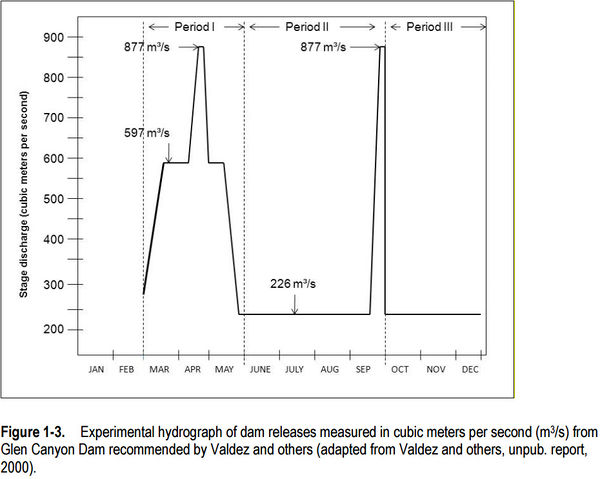Description of the Low Summer Flow Experiment
|
|
Low summer flows (minimum daily mean 5,000 to 8,000 cfs) for three months (Jul.–Sep.) to target ≥14°C at Little Colorado River confluence.
The experiment would not be conducted if:
- Release temperatures were too low to reach 14°C at Little Colorado River confluence even with going to a minimum flow of 5,000 to 8,000 cfs, or
- Release temperature were predicted to be high enough in July, August, or September to reach 14°C at Little Colorado River confluence under normal operations.
|
Objectives
|
|
Increase humpback chub growth
|
Trigger
|
|
Initial experiment: in the second 10 years of the LTEMP period (2026-2036) when target temperature of ≥14°C can be achieved only with low summer flow
Subsequent experimental use if:
- Initial test was successful,
- Humpback chub population concerns warrant their use,
- Water temperature appears to be limiting recruitment, and
- Target temperature of ≥14°C could be achieved only with low summer flow.
|
Offramps
|
- Low summer flows do not increase growth and recruitment of humpback chub
- Increase in warmwater nonnative species or trout at the Little Colorado River
- Longterm unacceptable adverse impacts on the resources listed in Section 1.3 are observed, or
- Sufficient warming does not occur as predicted
|
Risks
|
- Reduced food availability to humpback chub by
- desiccating the nearshore environment with the reduction in flow between June and July, and
- reducing drift with the reduction in daily fluctuation.
- Increased bioenergetic demands of humpback chub via warmer water while decreasing food supply and availability.
- Increased sediment transport during the high releases in the months prior to the LFS test in order to get the annual volume commitment to the Lower Basin.
- Increased the potential for nonnative fish and parasites to proliferate throughout the Grand Canyon.
|
Implementation Issues
|
- Modeling release temperatures far enough in advance to start making releases to meet annual release requirements
- Scheduling monthly releases in order to meet annual release requirements while dealing with uncertanties in inflow forcasts.
- Science planning to monitor affects
|
|
Links
|
|
|
Papers and Publications
|
|
|
Other Stuff
|
|
|
|
